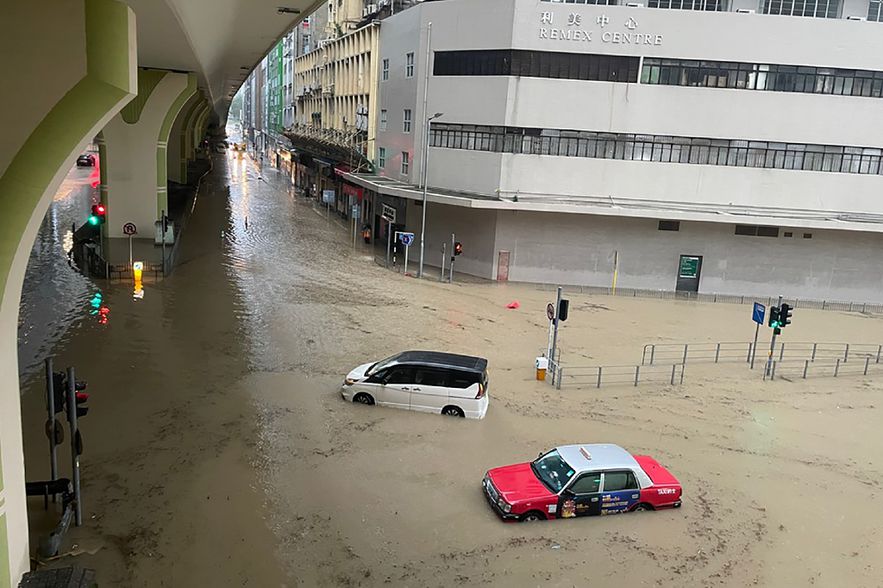Hong Kong was hit on Friday by the worst rainfall ever recorded since records began in 1884, which submerged streets and subway stations, forcing schools to close, less than a week after the passage of a super typhoon.
In total, 600 mm of water (or 600 liters of water per square meter) fell in 24 hours, or a quarter of the average annual precipitation, said the Hong Kong Observatory, the city’s meteorological agency.
The black alert, the highest level of alert, was triggered and residents were asked to stay at home. The Hong Kong Stock Exchange, the largest market in Asia, remained closed. “My whole neighborhood is isolated by the floods,” Olivia Lam, who lives in the eastern sector of the island, told AFP. “One of the underground car parks in the neighborhood is completely flooded and around my residence the water is waist deep,” she added.
General view of a flooded street after heavy rain, in Hong Kong, September 7, 2023
© / afp.com/Dene CHEN
Shenzhen is also affected
In the streets of the financial center of the island, the waves have pushed abandoned cars and drained a multitude of debris torn by the torrential rains. The Chinese metropolis of Shenzhen, bordering Hong Kong, has also been affected since Thursday by torrential rains, the heaviest ever recorded since 1952, according to state media.
The region has seen extreme weather and record temperatures this summer, events that scientists say are further exacerbated by climate change. The Hong Kong Observatory reported that up to 158.1 millimeters fell in one hour overnight, a level not recorded in 140 years.
“It’s like pouring the contents of four bathtubs into a bathtub: it overflows,” summarized Eric Chan, number two in local government, during a press conference, referring to “a hundred-year flood”. According to the authorities, “these extreme conditions” will continue until midnight (4:00 p.m. GMT). More than 80 people called hospital emergency services.
In addition to schools, authorities have closed freight clearance services at the border between Hong Kong and Shenzhen. This metropolis has 17.7 million inhabitants and is the headquarters of many technology companies.

Vehicles stranded on a flooded road in Hong Kong, September 8, 2023
© / afp.com/Libby HOGAN
The suspended metro
The Hong Kong metro operator has partially suspended services on one of its lines after a station was flooded. On social networks, Internet users have posted images showing a metro not stopping at Wong Tai Sin station, whose platform is invaded by water.
Other stations are also affected. On several roads, cars and buses were half submerged. An AFP journalist saw landslides blocking a two-lane road in the Shau Kei Wan district.
“It’s a painful experience,” laments Eli, a commuter frustrated by his inability to reach his workplace in the south of Hong Kong island.
Roads are also flooded with rain on the neighboring island of Lantau where rivers have burst their banks. The Bloomberg Intelligence agency estimated the cost of the damage at at least 93 million euros. According to the Hong Kong Observatory, the torrential rains were caused by the “trough of low pressure associated with the rest of Haikui”.
Intense tropical storms
Typhoon Haikui swept through Taiwan at the start of the week, injuring around a hundred people, uprooting trees and damaging roads, before heading towards southern China, downgraded to a storm.
Southern China was hit last weekend by two successive typhoons, Saola and Haikui. Climate change has increased the intensity of tropical storms, with more rain and stronger gusts causing flash flooding and coastal damage, experts say.
